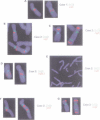Abstract
Few cases of isochromosomes for the short arm of the X have been reported and all are dicentric with variable portions of the long arms interposed between the two centromeres. This paper reports three cases of complete short arm duplication of one X chromosome in unrelated female patients. All patients also have a 45,X cell line and present with some characteristic features of Turner syndrome. We used conventional cytogenetics, in situ hybridisation, and molecular genetics to describe all three structurally abnormal chromosomes and the parental origin of two of them. We briefly discuss the "inactivation enhancement" theory; however, any genotype-phenotype correlation is complicated by the presence of the 45,X cell line.
Full text
PDF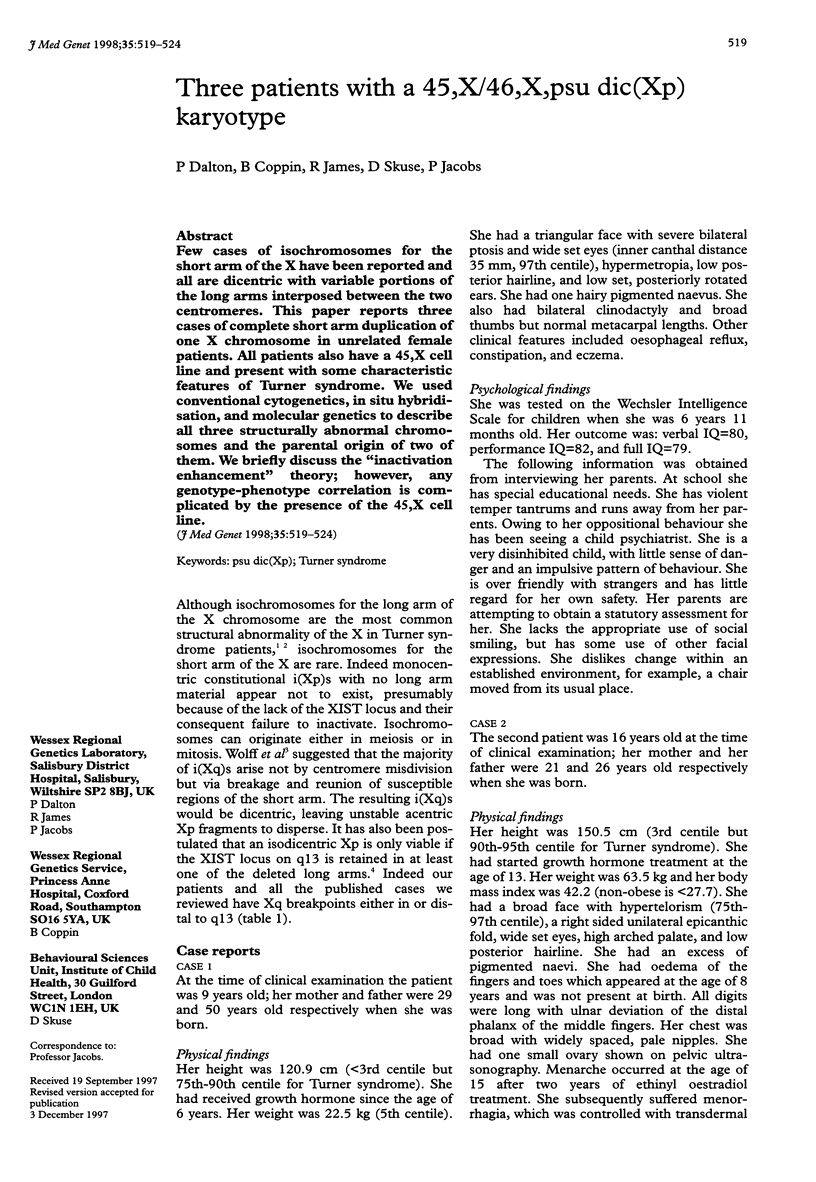
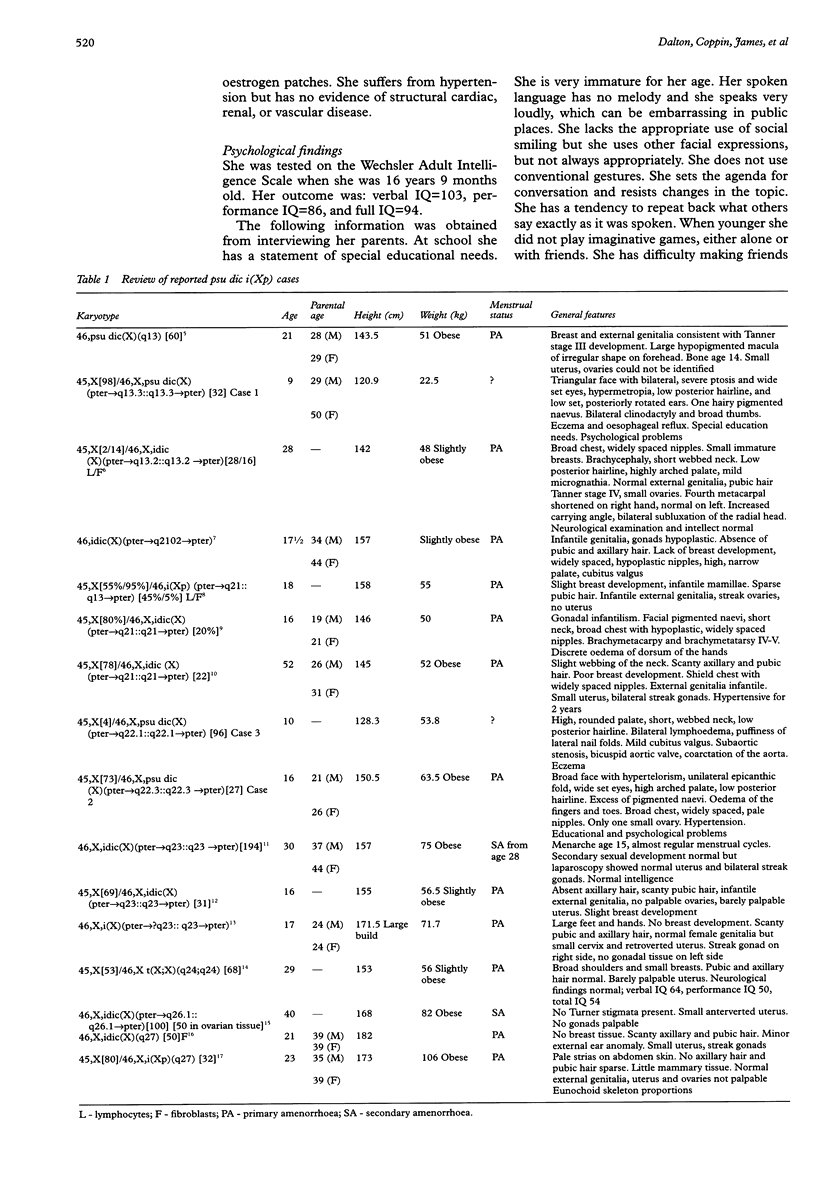
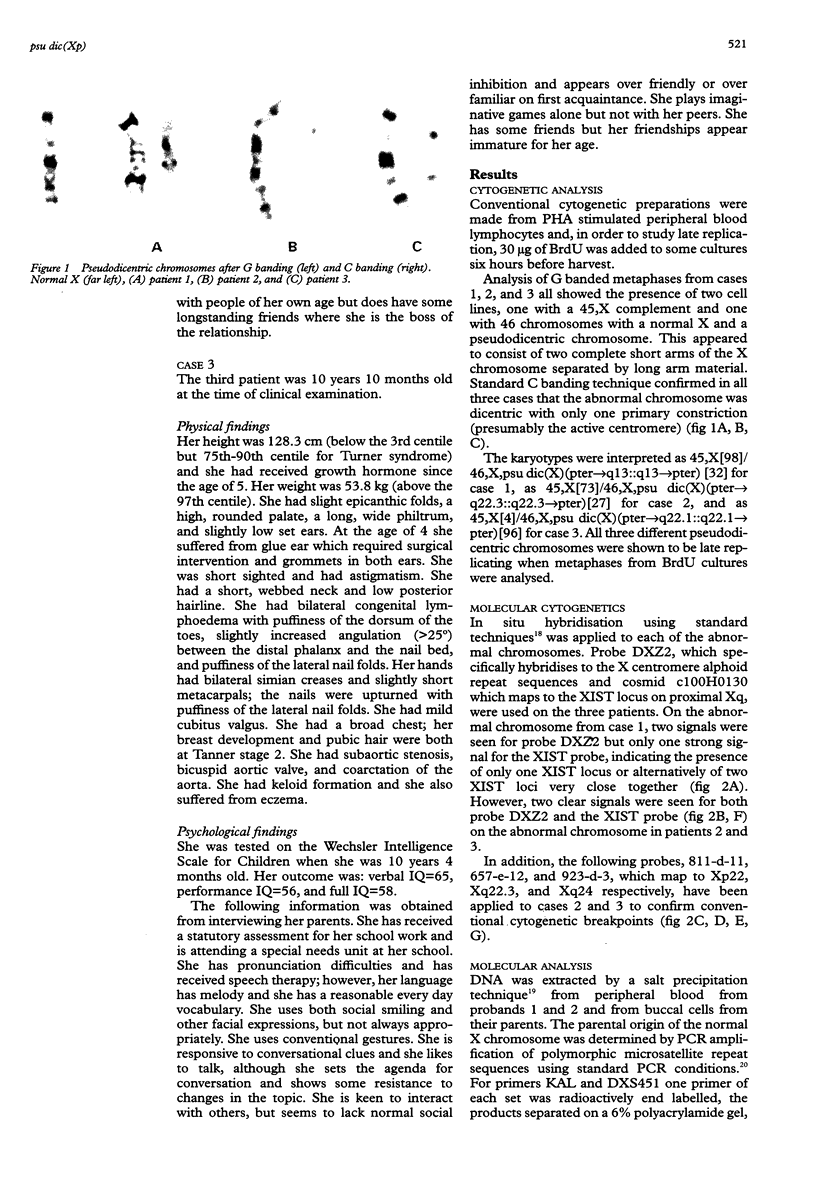
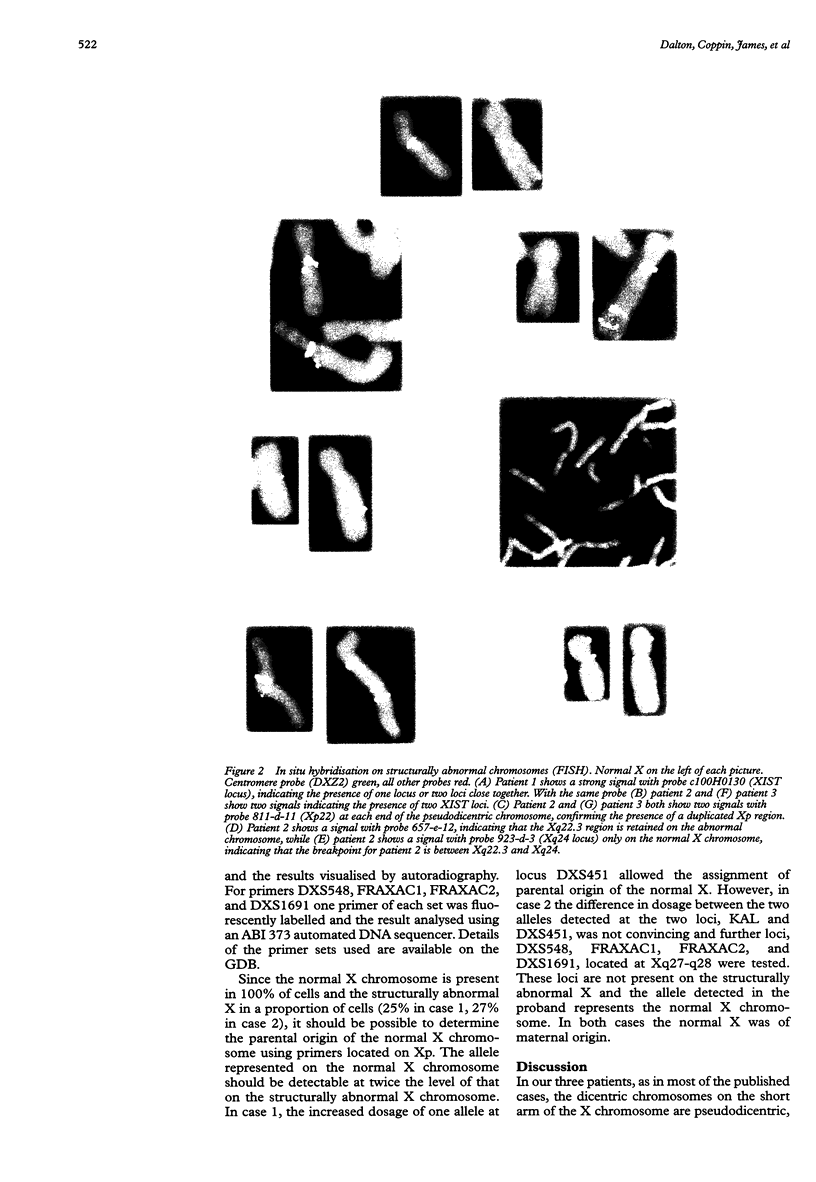
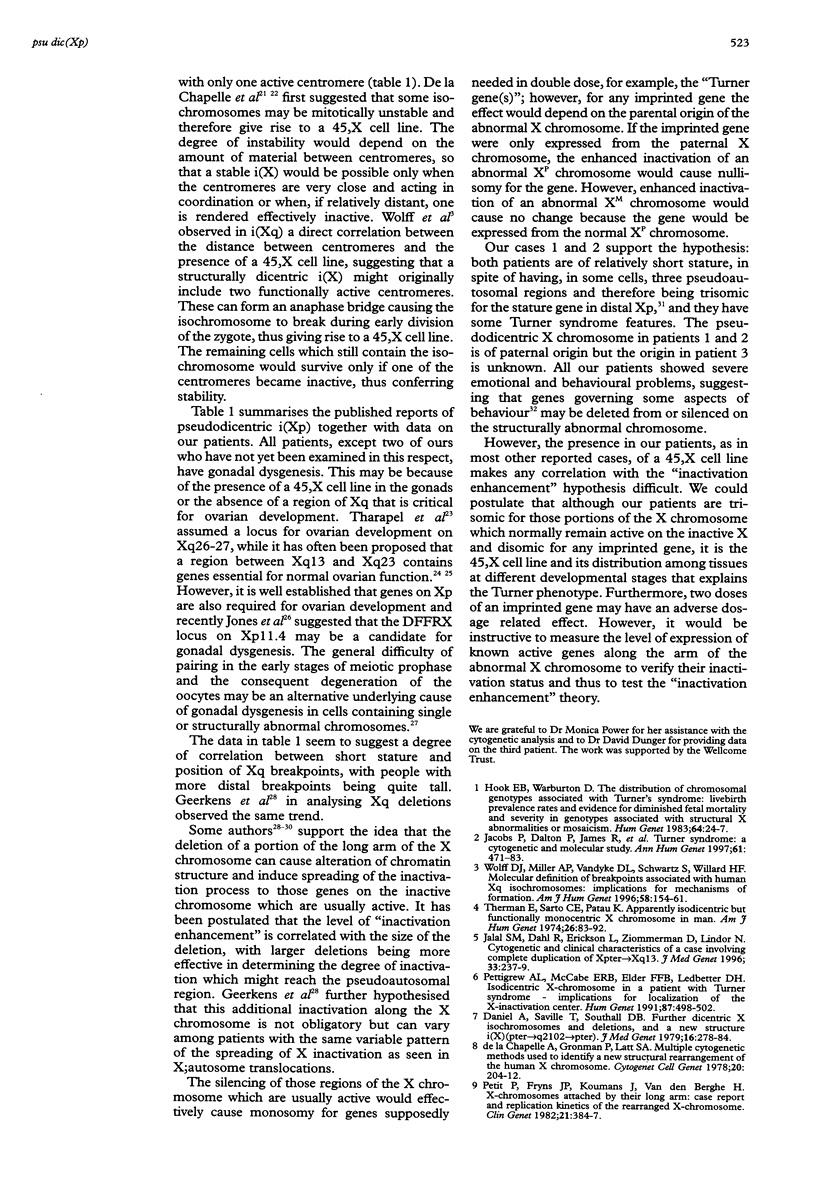
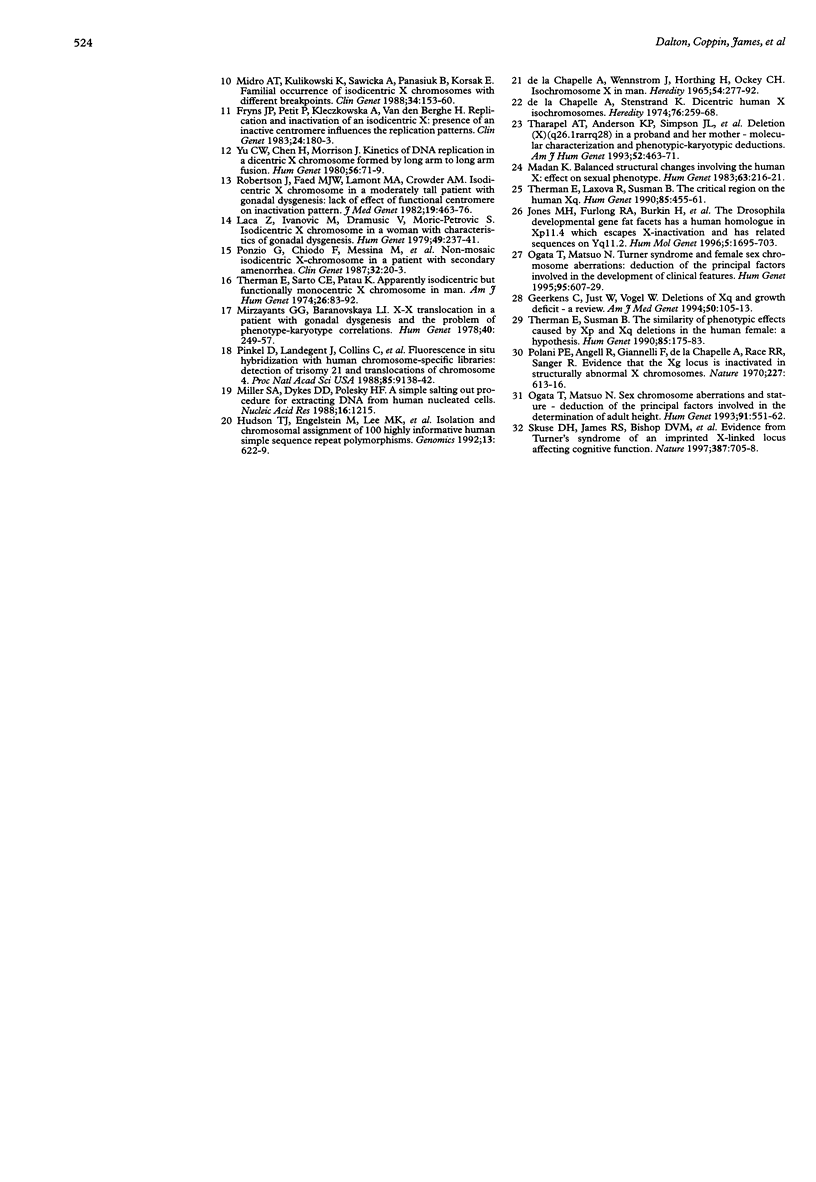
Images in this article
Selected References
These references are in PubMed. This may not be the complete list of references from this article.
- Daniel A., Saville T., Southall D. B. Further dicentric X isochromosomes and deletions, and a new structure i(X)(pter to q2102 to pter). J Med Genet. 1979 Aug;16(4):278–284. doi: 10.1136/jmg.16.4.278. [DOI] [PMC free article] [PubMed] [Google Scholar]
- De la Chapelle A., Stenstrand K. Dicentric human X chromosomes. Hereditas. 1974;76(2):259–268. doi: 10.1111/j.1601-5223.1974.tb01344.x. [DOI] [PubMed] [Google Scholar]
- Fryns J. P., Petit P., Kleczkowska A., van den Berghe H. Replication and inactivation of an isodicentric X: presence of an inactive centromere influences the replication patterns. Clin Genet. 1983 Sep;24(3):180–183. doi: 10.1111/j.1399-0004.1983.tb02236.x. [DOI] [PubMed] [Google Scholar]
- Geerkens C., Just W., Vogel W. Deletions of Xq and growth deficit: a review. Am J Med Genet. 1994 Apr 1;50(2):105–113. doi: 10.1002/ajmg.1320500202. [DOI] [PubMed] [Google Scholar]
- Hook E. B., Warburton D. The distribution of chromosomal genotypes associated with Turner's syndrome: livebirth prevalence rates and evidence for diminished fetal mortality and severity in genotypes associated with structural X abnormalities or mosaicism. Hum Genet. 1983;64(1):24–27. doi: 10.1007/BF00289473. [DOI] [PubMed] [Google Scholar]
- Hudson T. J., Engelstein M., Lee M. K., Ho E. C., Rubenfield M. J., Adams C. P., Housman D. E., Dracopoli N. C. Isolation and chromosomal assignment of 100 highly informative human simple sequence repeat polymorphisms. Genomics. 1992 Jul;13(3):622–629. doi: 10.1016/0888-7543(92)90133-d. [DOI] [PubMed] [Google Scholar]
- Jacobs P., Dalton P., James R., Mosse K., Power M., Robinson D., Skuse D. Turner syndrome: a cytogenetic and molecular study. Ann Hum Genet. 1997 Nov;61(Pt 6):471–483. doi: 10.1046/j.1469-1809.1997.6160471.x. [DOI] [PubMed] [Google Scholar]
- Jalal S. M., Dahl R., Erickson L., Zimmerman D., Lindor N. Cytogenetic and clinical characteristics of a case involving complete duplication of Xpter-->Xq13. J Med Genet. 1996 Mar;33(3):237–239. doi: 10.1136/jmg.33.3.237. [DOI] [PMC free article] [PubMed] [Google Scholar]
- Jones M. H., Furlong R. A., Burkin H., Chalmers I. J., Brown G. M., Khwaja O., Affara N. A. The Drosophila developmental gene fat facets has a human homologue in Xp11.4 which escapes X-inactivation and has related sequences on Yq11.2. Hum Mol Genet. 1996 Nov;5(11):1695–1701. doi: 10.1093/hmg/5.11.1695. [DOI] [PubMed] [Google Scholar]
- Laća Z., Ivanović M., Dramusić V., Morić-Petrović S. Isodicentric X chromosome in a woman with characteristics of gonadal dysgenesis. Hum Genet. 1979 Jun 19;49(2):237–241. doi: 10.1007/BF00277649. [DOI] [PubMed] [Google Scholar]
- Madan K. Balanced structural changes involving the human X: effect on sexual phenotype. Hum Genet. 1983;63(3):216–221. doi: 10.1007/BF00284652. [DOI] [PubMed] [Google Scholar]
- Midro A. T., Kulikowski M., Sawicka A., Panasiuk B., Korsak E. Familial occurrence of isodicentric X chromosomes with different breakpoints. Clin Genet. 1988 Sep;34(3):153–160. doi: 10.1111/j.1399-0004.1988.tb02855.x. [DOI] [PubMed] [Google Scholar]
- Miller S. A., Dykes D. D., Polesky H. F. A simple salting out procedure for extracting DNA from human nucleated cells. Nucleic Acids Res. 1988 Feb 11;16(3):1215–1215. doi: 10.1093/nar/16.3.1215. [DOI] [PMC free article] [PubMed] [Google Scholar]
- Mirzayants G. G., Baranovskaya L. I. X-X translocation in a patient with gonadal dysgenesis and the problems of phenotype-karyotype correlations. Hum Genet. 1978 Feb 16;40(3):249–257. doi: 10.1007/BF00272185. [DOI] [PubMed] [Google Scholar]
- Ockey C. H., Wennström J., De la Chapelle A. Isochromosome-X in man. II. Hereditas. 1966;54(3):277–292. doi: 10.1111/j.1601-5223.1966.tb02022.x. [DOI] [PubMed] [Google Scholar]
- Ogata T., Matsuo N. Sex chromosome aberrations and stature: deduction of the principal factors involved in the determination of adult height. Hum Genet. 1993 Jul;91(6):551–562. doi: 10.1007/BF00205079. [DOI] [PubMed] [Google Scholar]
- Ogata T., Matsuo N. Turner syndrome and female sex chromosome aberrations: deduction of the principal factors involved in the development of clinical features. Hum Genet. 1995 Jun;95(6):607–629. doi: 10.1007/BF00209476. [DOI] [PubMed] [Google Scholar]
- Petit P., Fryns J. P., Koumans J., van den Berghe H. X-chromosomes attached by their long arm: case report and replication kinetics of the rearranged X-chromosome. Clin Genet. 1982 Jun;21(6):384–387. doi: 10.1111/j.1399-0004.1982.tb01392.x. [DOI] [PubMed] [Google Scholar]
- Pettigrew A. L., McCabe E. R., Elder F. F., Ledbetter D. H. Isodicentric X chromosome in a patient with Turner syndrome--implications for localization of the X-inactivation center. Hum Genet. 1991 Aug;87(4):498–502. doi: 10.1007/BF00197176. [DOI] [PubMed] [Google Scholar]
- Pinkel D., Landegent J., Collins C., Fuscoe J., Segraves R., Lucas J., Gray J. Fluorescence in situ hybridization with human chromosome-specific libraries: detection of trisomy 21 and translocations of chromosome 4. Proc Natl Acad Sci U S A. 1988 Dec;85(23):9138–9142. doi: 10.1073/pnas.85.23.9138. [DOI] [PMC free article] [PubMed] [Google Scholar]
- Polani P. E., Angell R., Giannelli F., De la Chapelle A., Race R. R., Sanger R. Evidence that the Xg locus is inactivated in structurally abnormal X chromosomes. Nature. 1970 Aug 8;227(5258):613–616. doi: 10.1038/227613a0. [DOI] [PubMed] [Google Scholar]
- Ponzio G., Chiodo F., Messina M., Surico N., Libanori E., Folpini E., Porcelli A., Marchese C. Non-mosaic isodicentric X-chromosome in a patient with secondary amenorrhea. Clin Genet. 1987 Jul;32(1):20–23. doi: 10.1111/j.1399-0004.1987.tb03317.x. [DOI] [PubMed] [Google Scholar]
- Robertson J., Faed M. J., Lamont M. A., Crowder A. M. Isodicentric X chromosome in a moderately tall patient with gonadal dysgenesis: lack of effect of functional centromere on inactivation pattern. J Med Genet. 1982 Dec;19(6):463–465. doi: 10.1136/jmg.19.6.463. [DOI] [PMC free article] [PubMed] [Google Scholar]
- Skuse D. H., James R. S., Bishop D. V., Coppin B., Dalton P., Aamodt-Leeper G., Bacarese-Hamilton M., Creswell C., McGurk R., Jacobs P. A. Evidence from Turner's syndrome of an imprinted X-linked locus affecting cognitive function. Nature. 1997 Jun 12;387(6634):705–708. doi: 10.1038/42706. [DOI] [PubMed] [Google Scholar]
- Tharapel A. T., Anderson K. P., Simpson J. L., Martens P. R., Wilroy R. S., Jr, Llerena J. C., Jr, Schwartz C. E. Deletion (X)(q26.1-->q28) in a proband and her mother: molecular characterization and phenotypic-karyotypic deductions. Am J Hum Genet. 1993 Mar;52(3):463–471. [PMC free article] [PubMed] [Google Scholar]
- Therman E., Laxova R., Susman B. The critical region on the human Xq. Hum Genet. 1990 Oct;85(5):455–461. doi: 10.1007/BF00194216. [DOI] [PubMed] [Google Scholar]
- Therman E., Sarto G. E., Patau K. Apparently isodicentric but functionally monocentric X chromosome in man. Am J Hum Genet. 1974 Jan;26(1):83–92. [PMC free article] [PubMed] [Google Scholar]
- Therman E., Sarto G. E., Patau K. Apparently isodicentric but functionally monocentric X chromosome in man. Am J Hum Genet. 1974 Jan;26(1):83–92. [PMC free article] [PubMed] [Google Scholar]
- Therman E., Susman B. The similarity of phenotypic effects caused by Xp and Xq deletions in the human female: a hypothesis. Hum Genet. 1990 Jul;85(2):175–183. doi: 10.1007/BF00193192. [DOI] [PubMed] [Google Scholar]
- Wolff D. J., Miller A. P., Van Dyke D. L., Schwartz S., Willard H. F. Molecular definition of breakpoints associated with human Xq isochromosomes: implications for mechanisms of formation. Am J Hum Genet. 1996 Jan;58(1):154–160. [PMC free article] [PubMed] [Google Scholar]
- Yu C. W., Chen H., Morrison J. Kinetics of DNA replication in a dicentric X chromosome formed by long arm to long arm fusion. Hum Genet. 1980;56(1):71–79. doi: 10.1007/BF00281572. [DOI] [PubMed] [Google Scholar]
- de la Chapelle A., Grönman P., Latt S. A. Multiple cytogenetic methods used to identify a new structural rearrangement of the human X chromosome. Cytogenet Cell Genet. 1978;20(1-6):204–212. doi: 10.1159/000130852. [DOI] [PubMed] [Google Scholar]




